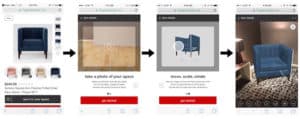Target Corp. is the latest retailer to add augmented reality to its mobile shopping experience.
Target, No. 20 in the Internet Retailer 2017 Top 1000, has 200 furniture products available for shoppers to view in augmented reality, and it plans to launch hundreds more by year-end and thousands more in 2018, the retailer says. Currently, all of the 3-D products are part of Target’s Project 62 furniture brand; the retailer plans to expand its 3-D product assortment to more home furnishing products, a Target spokeswoman says.
“This new augmented reality feature helps our guests visualize how products will look in their home and gives them confidence that they are purchasing the best item for their space,” a Target spokeswoman says.

Here’s how it works: A shopper on the mobile web visits Target.com and can see a separate section of products available in augmented reality. On the product detail page, she taps the “see it in your room” button. She then takes a picture of the room she wants to see the product in. The 3-D product image then appears on the picture on her screen. She can move the product around the picture and adjust the size with her finger.
Because the products are adjustable, Target shows the dimensions next to the product on the screen.
“Rendering products to scale is something we’ll continue to work on and refine,” the Target spokeswoman says. “That’s why in our first release of this experience we have included product dimensions to help guests better gauge item sizing as they view the virtual image in their space.”
Target’s augmented reality feature does not use specific software, scanners and depth-sensing cameras that are needed for to-scale augmented reality features.
Retailers such as Wayfair Inc. (No. 16), Lowe’s Cos. Inc. (No. 25). and Overstock.com Inc. (No. 30), have implemented augmented reality with to-scale products. However, these features are only available to shoppers who have the retailer’s app and have a smartphone with Google’s Tango technology or Apple Inc.’s iOS 11 operating system.
Target embedded its augmented reality feature into its mobile website instead of creating an app because it wanted to make the tool more widely accessible.
“We can reach a wider audience more quickly with mobile web, but we plan to add the capability into the Target app down the road,” says the spokeswoman. Target will evaluate how shoppers use the feature and their feedback for potential updates.
Target developed the AR feature in six months with in-house technology teams in India and in the Minneapolis-St. Paul area, says the spokeswoman, who declined to say how large the teams were or what the project cost.
Target developed the 3-D product models in two ways: It used propriety photogrammetry, which is the science of making measurements from photographs, that involves using images of a product at every angle and merging them together to create the model. Target also had a team of model, texture, lighting and visual artists that built the models based on a product’s, size, pattern and texture.
